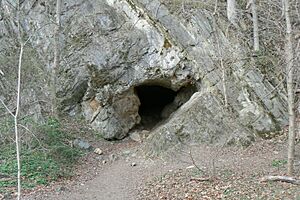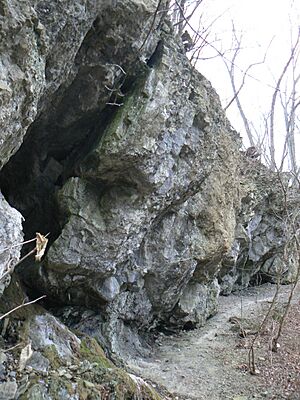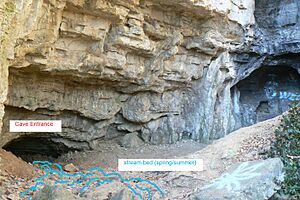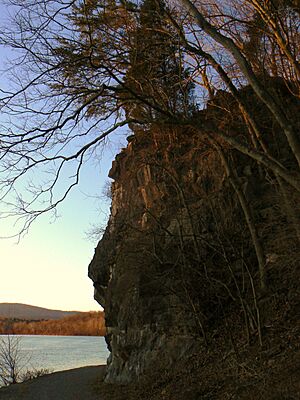List of caves of Maryland facts for kids
Maryland is a state in the United States that has many cool caves! Most of these caves are found in the western parts of the state, in counties like Washington, Allegany, and Garrett. A cave is usually defined as any underground space big enough for a person to enter. This means that even some rock shelters or old mines might be counted as caves in Maryland.
Exploring Maryland's Caves
People have been studying and mapping Maryland's caves for a long time. The first big collection of information about these caves was put together in the mid-1940s by Martin Muma. He worked for the Maryland Geological Survey (MGS).
Later, a scientist named William Davies did a much bigger study. He spent years exploring caves, and all his hard work led to the first official book called Caves of Maryland, which came out in 1950.
After that, other groups and people tried to find even more information about Maryland's underground world. In the late 1960s, the MGS supported another big survey by Richard Franz and Dennis Slifer. Their work led to a second, much larger edition of Caves of Maryland in 1971. This second study was the first time that areas west of Washington County were really explored in detail. Even after their survey, people thought there might be even more undiscovered caves hidden in the remote western parts of the state. However, no new official state reports have been released since then.
How Maryland's Caves Form
Most of Maryland's caves are found in its three western counties: Washington, Allegany, and Garrett. Even though Maryland is smaller than some nearby states with more caves, its geology (the study of Earth's rocks and structures) is perfect for cave formation.
Most of these caves are called solutional caves. This means they are hollowed out by natural chemical processes. Imagine rainwater mixing with carbon dioxide in the air and soil. This creates a weak acid. When this acidic water seeps into the ground and meets certain types of rocks, like limestone, dolomite, or marble, it slowly dissolves the rock. Over thousands of years, this dissolving action creates small cracks, then bigger passages, and eventually large cave rooms.
Other types of caves, called non-solutional caves, are formed by things like weathering (wind and water breaking down rock) or by rocks shifting. These caves are usually smaller and not as interesting for people who enjoy exploring caves (called spelunkers).
To understand where caves are likely to form, it helps to know about the different rock types across Maryland. Let's take a quick trip across the state from east to west!
Eastern Maryland: Coastal Plain
This area stretches from just west of the Chesapeake Bay all the way to the Atlantic Ocean. The rocks here are mostly covered by layers of gravel, silts, marls, and sands. Because of this, there are no known solutional caves in this part of Maryland. The right kind of rock isn't exposed or isn't there.
Central Maryland: Piedmont Plateau
The Piedmont is an area of gently rolling hills and flatlands. It's home to only a few of Maryland's caves. This is because most of the rocks in this region aren't suitable for cave development, or they are hidden deep underground by towns and cities.
However, there are exceptions! In the uplands, you can find a few caves in areas with Wakefield and Cockeystown marbles. In the lowlands, especially in the Frederick Valley, caves are found in the Frederick Formation and Grove Limestone.
Western Maryland: Blue Ridge & the Great Valley
The Blue Ridge rises up from the Piedmont just west of Frederick. Here, older limestone and dolomite rocks from the Cambrian and Ordovician periods appear. These rocks offer a few caves in the Frederick and Middletown Valley areas.
South Mountain marks the western edge of Maryland's Blue Ridge. West of this, the land becomes flatter, an area known as the Great Valley (or locally as Hagerstown/Cumberland). Here, the harder rocks of the Blue Ridge are replaced by carbonates, sandstones, and shale.
The highest number of Maryland caves are found in the Hagerstown Valley. This is because waterways have cut into the underlying carbonate rocks, helping caves to form. Recent studies show that the most "cavernous" (cave-rich) rock layers in the Great Valley include the Tomstown Dolomite, the Cavetown member of the Waynesboro Formation, the lower beds of the Elbrook Formation, the Rockdale Run Formation, and especially the Chambersburg Formation.
However, caves also form depending on other features like anticlines (upward folds in rock layers) and faults (cracks where rocks have moved). Unlike the larger caves in nearby West Virginia, caves in the Great Valley are usually quite shallow. This is because faults allow surface water to go straight down to the water table quickly, limiting how much the caves can spread out sideways. Only Crystal Grottoes in Washington County is known to be longer than 1,000 feet, and it's more of a maze than one long passage.
Far Western Maryland: Ridge & Valley Region
This region stretches west from the Great Valley into the western part of Allegany County. It's known for its repeating ridges and valleys that run from southwest to northeast. The region is built on shale and sandstone, but you start to see cave-bearing limestone in the lower Helderberg Group, Wills Creek Formation, and Tonoloway Formation. Some of the largest caves in the state can be found in the thicker formations of the upper Devonian period, like the Keyser Formation and New Creek Limestone.
Allegany Plateau
The Allegany Plateau is a rolling upland with deep valleys and distinct, broad anticlines. Here, limestone formations continue into the lower Devonian period. The youngest rocks that contain caves in Maryland are found in Garrett County and are from the Pennsylvanian age.
The Greenbrier Formation is a relatively thin limestone layer in this region, but it contains eight known large caves, including Maryland's biggest cave, Tanglefoot Cave.
Cool Caves of Maryland
Here's a list of some of the interesting caves found in Maryland, organized by county.
Allegany County
- Atheys Cave - This cave is found in the Tonoloway Formation. It has a hidden entrance that's a sloping pit about 6 feet deep. Inside, you'll find four rooms and several pools of water.
- Cumberland Bone Cave - Discovered in 1912 during railway construction, this cave was a treasure trove of ancient animal fossils from the Ice Age! These fossils were sent to the U.S. National Museum. The cave was a small room filled with clay and rock.
- Cumberland Quarry - Located in the Wills Creek Formation, this cave has two 20-foot-long crawlways inside a quarry.
- Devils Den - Found south of Flintstone, this cave was a favorite play area for children in the past. It's connected to a branch of Flintstone Creek and reappears as a large spring.
- Devil's Hole - This cave is a vertical shaft that reportedly connects to two small rooms at its bottom. It's considered one of the largest and most interesting caves in Allegany County.
- Goat Cave - This cave has a very low ceiling, less than 4 feet high, and is found in the Wills Creek Formation.
- Greises Cave - This cave has a 20-foot-wide chamber and a steep passage that's about 200 meters (656 feet) long. It can even have a waterfall inside during wet seasons!
- Horse Cave (also known as Dead Horse Cave) - This cave is relatively shallow, with only 8 to 10 feet of rock above its entrance room.
- Murley Branch Spring - This cave has a low, water-filled opening. In 1925, some men explored it during a very dry season and found a passage extending 300 meters (984 feet) with at least three deep pits.
- Rocky Gap - This is a fissure cave, meaning it's a long, narrow crack in the rock. It extends about 120 meters (394 feet) and is usually 5 feet wide and 5 to 10 feet high.
- Twiggs Cave - This cave was first opened in 1898. It formed as two parallel cracks and has a lot of clay inside, possibly from an underground stream. It features a series of six pits, with the largest one called the "King's Chair" leading to a lower tunnel.
Baltimore County
- Beaver Run Shelter - A small rock shelter that's about 20 feet long and ends in a 10-foot-wide room.
Carroll County
- Westminster Cave - The entrance to this cave was covered with a wooden door in an old quarry. It was a single room, and at one point, the entrance room had a concrete floor and was used to cool milk!
Frederick County
- Buckeystown Cave - This cave has a 25-foot vertical shaft that leads to a single room measuring 20 feet long by 18 feet wide.
- Centerville Cave - This cave was reported to have four small rooms in an old quarry.
- Le Gore Quarry-Powells Cave - Powells Cave used to have a crawlway extending 100 feet, but it's now blocked. Nearby, other openings in the quarry might connect to it.
- Linganore Shelter - There are stories of small rock shelters here with Native American drawings (pictographs), but they have been hard to find.
- McKinstrys Mill - This cave is less than 100 feet long and is found west of the mill with the same name.
- Monocacy River Cave - This cave is located just above the Monocacy River. It's about 4 feet wide and 2 feet high at the entrance and extends over 25 feet.
Garrett County
- Crabtree Cave - This used to be the largest cave in Maryland, but now Tanglefoot Cave is bigger. It has at least 4,200 meters (13,780 feet) of mapped passages! You can even explore it in a circuit, which can take about seven hours. This cave is gated, so you need permission to enter. It's protected by The Nature Conservancy.
- John Friends Cave - This cave has been known since 1751, with historical graffiti from that time! A stream enters the cave in several places. It's also protected by The Nature Conservancy.
- Muddy Creek Falls Shelter - Two small rock shelters are found at the base of Muddy Creek Falls in Swallow Falls State Forest. The largest is 25 feet long.
- Sand Cave - This is the largest shelter-type cave in Maryland. In the past, it was used by Native Americans as a home, and arrowheads and other items have been found inside. The entrance is wide but low and almost hidden by ferns and moss.
- Woods Place Cave - This cave was reported to have an entrance leading down step-like terraces for 50 feet to a passage of unknown length, but it was not found in 1950.
Howard County
- Camels Den - This is a shallow rock shelter measuring about 15 by 6 feet wide and 8 feet high. Archaeological digs here have found many artifacts.
Washington County
- Antietam Cave - This cave was a crawlway about 100 feet long.
- Busheys Cavern - This cave was once open to the public as a show cave in 1823, costing 12 and a half cents to enter! It was originally a source of saltpeter (used to make gunpowder). Sadly, it was later destroyed by quarrying and blasting.
- Crystal Grottoes - This is Maryland's only official show cave! It was discovered in 1920 during quarry operations. You can visit it today!
- Dam No. 4 Cave - Located along the C&O Canal, this cave has a large entrance (15 feet wide and 20 feet high) and extends over 100 feet.
- Dargan Quarry Cave - A small part of a former cave remains in the Dargan quarry, extending 20 feet before being blocked by fallen rock.
- Dellingers Cave - This cave is entered through a small hole that leads to a corridor and then a large room. It has elaborate sub-levels and continuing passages.
- Fairview Cave - Located near Conococheague Creek, this cave is mostly a crawlway less than 100 feet long, made up of damp clay.
- Howell Cave - This cave consists of a 12-foot-long crawlway that connects to two rooms. It was reported to connect to a sinkhole 700 yards away.
- Houpt Cave - The entrance to this cave is in a low ledge in front of a house, leading to 80 feet of passage. A stream flows out of the entrance.
- Mt. Aetna Cave - Discovered in 1931, this cave was briefly opened commercially in 1932 but closed due to lack of visitors. The main passage is over 350 feet long and decorated with stalactites and columns.
- Pine Hill Cave - This cave is a vertical shaft about 50 feet deep. At the bottom, a stream passage continues for over 100 feet.
- Pinesburg Cave - Located near the top of a cliff along the C&O Canal, this cave extends about 45 feet.
- Revells Cave - The entrance to this cave leads to a maze of small, winding passages. It's reported that the cave continues through the hill for 1,000 feet and connects to another entrance.
- Rohrersville Caves - Two caves are found here, one in an old quarry and another in a shallow sinkhole.
- Round Top Caves (Nos. 1-7) - Several caves are found around Round Top.
- Round Top #1 has a steeply sloped entrance leading to a 30-foot drop into a narrow room.
- Round Top #2 is a straight passage extending over 400 feet.
- Round Top #3 is a large rock shelter, 50 feet wide, 20 feet high, and 40 feet long.
- Round Top #4 was a crawlway extending 100 feet.
- Round Top #5 has a steep crawlway leading into a large room that's 100 feet long, 20 feet wide, and 50 feet high.
- Round Top #6 opens into a 400-foot-long room that is 100 feet wide.
- Round Top #7 is a low passage about 30 feet long that opens into a 150-foot-long room.
- Schetrompf Cave - This cave has a 2-foot-wide by 8-foot-tall crack entrance that leads to a 15-foot-deep pit and reportedly connects to a 30-foot-diameter room.
- Sharpsburg Shelters - Several small rock shelters are located in the bluffs along the C&O Canal. One is 35 feet wide and 25 feet high, extending 45 feet. Another is a winding crawlway about 200 feet long.
- Snively Cave no. 1 - This cave is a low crawlway that drops 8 feet into a 15-foot-diameter room. A large part of it was removed during quarry operations.
- Snively Cave no. 2 - The entrance to this cave is a fissure with a 15-foot drop, leading to passages 5 to 10 feet wide that continue for about 100 feet.
- Two Locks Caves - Three small caves are found in the bluffs along the C&O Canal towpath. The northernmost cave extends 30 feet. The second cave is a fissure that probably connects to the third cave.





